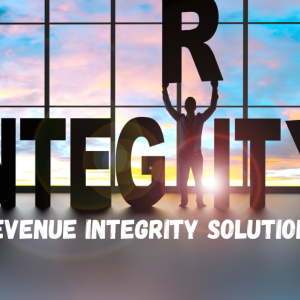Maintaining revenue integrity is a complex juggling act. The revenue integrity team must have the right people, processes, technology, and communications to ensure that clean bills go out, denied claims get reworked promptly, and external audit requests are answered quickly.
The goal, of course, is to maximize revenue retention, which starts with correctly coding and billing professional and hospital claims. An MDaudit analysis shows that, on average, up to 25% of overall revenue can be retained by resolving accuracy issues in billing and coding operations.
The biggest barriers to healthy revenue integrity are:
- Data volume
- Bandwidth
- External audits
- Denials
- Data/Communication silos
Having the right technology is a critical success factor in maintaining revenue integrity. Technology should aggregate data from various sources to identify potential compliance and revenue risks, so organizations can quickly take corrective actions to minimize issues while maximizing legitimate reimbursement opportunities.
Further, to drive value, revenue teams must be able to work cross-functionally across the enterprise with compliance, health information management, coding, pharmacy, revenue cycle, and clinical documentation improvement counterparts. Breaking down existing information and communication silos requires leveraging common data sources, technology platforms, and insight-sharing mechanisms.
1. Data volume.
Hospitals are drowning in data. Claims data. Remittance data. Denials data. Clinical data. Insurance rules. Internal audit data and metrics. External audit requests. And much more. The data stream won’t be staunched anytime soon, so the key becomes how to manage the flow adequately.
Revenue integrity starts with bringing those disparate datasets into a central location where they can be managed in a uniform manner, using technology to help staff make sense of the data and to cut through the clutter. When an external audit request comes in, the clock starts ticking on the response. In this instance, time is literally money. Using a robust auditing technology platform ensures that data can be quickly located so audits are answered in a timely manner.
2. Bandwidth.
While data continues to swamp billing and auditing teams, fewer staff are available to stem the tide. Revenue cycle management (RCM) staffing shortages were common before the pandemic hit but have been exacerbated by burnout and resignations at a time when demand for qualified personnel has never been higher.
Nearly half of revenue cycle leaders in a 2022 survey indicated their departments were facing severe labor shortagess, with more than four in 10 noting that 51%-75% of their revenue cycle/billing roles were currently vacant. RCM staffing shortages can have an outsized financial impact, including costs related to recruitment, onboarding, training, retention, overtime pay, and the temp staff to prevent backlogs. Labor costs increased by 22% between 2021 and 2022.
Comprehensive auditing software can help RCM professionals concentrate on those areas that have the best potential upside.
3. External audits.
MDaudit research shows that risk-based audits increased by 28% in 2022, and prospective audits rose by 32%. Internal auditing is important to maintaining revenue integrity, but organizations must also keep pace with the ever-expanding volume of external audit requests.
Aided by massive investments in predictive modeling and artificial intelligence (AI) tools to scrutinize claims more closely prior to adjudication, federal agencies, including the Centers for Medicare & Medicaid Services (CMS) and the U.S. Department of Health and Human Services (HHS) Office of Inspector General (OIG) have announced plans for greater numbers of external audits. Earlier federal auditing efforts have returned $8 for each $1 spent, so these efforts are likely to continue.
Nearly one-third of healthcare organizations still use spreadsheets to manage their audit programs, a manual process that is both time-consuming and error-prone. An advanced audit platform can pull data from various sources in one location to empower strategic decisions.
4. Denials.
Solving the denial challenge is like trying to extinguish a smoldering fire — put it out in one area, and a hot spot emerges elsewhere that needs attention. Payer policies frequently change; new requirements are established; coders can have an off day, and new clinicians need additional training.
The frequency and dollar amounts of rejected claims are increasing, and payers are taking longer to respond to first claims. MDaudit research shows payers in 2021 initially rejected:
- 12% of total professional charges at $288 per claim
- 26% of total hospital outpatient charges at $602 per claim
- 27% of total hospital inpatient charges at $5,810 per claim
Multiply each claim denial by the number of denials per day or week, and the missed revenue adds up quickly. These factors equate to longer reimbursement windows, which negatively impacts revenue.
By submitting clean claims the first time and having processes and technology in place to quickly spot and remediate denial trends, hospitals can create a culture where revenue integrity is a central tenet.
5. Data/Communication silos
Maintaining revenue integrity isn’t just the responsibility of the revenue cycle department. Data, especially claims and remittance/payment data is typically collected by multiple departments, including coding and revenue cycle management. But data must be viewed from a 360-degree vantage point to be truly actionable.
Spreadsheets aren’t the answer, and neither is technology that fails to aggregate data across departments.
Hospitals need a solution that combines fully integrated risk capabilities and supporting workflows on a single platform. It should provide denials analytics technology that can pre-emptively protect revenue by identifying and resolving systemic risks based on historical data and applied insights. The most impactful platform will deliver workflow automation, risk monitoring, built-in analytics, benchmarking capabilities, augmented intelligence, and revenue cycle management best practices.
By creating a closed-loop feedback process among insights, actions, and outcomes to manage high-impact denials and improve overall revenues, hospitals can proactively address the issues that lead to costly inpatient and outpatient claim denials.
Maintaining revenue integrity isn’t the responsibility of a single department. To meet changing and complex risks, revenue integrity staff must leverage data and collaborate cross-functionally with coding, billing, finance, and others.
Denials and audits aren’t going away, and staff shortages won’t be fixed overnight. Overcoming these five barriers requires a “work smarter, not harder” mindset that includes a single platform for claims, denial, and audit data. Learn more about how revenue integrity can be achieved at your organization in this recorded webinar, Best Practices for Strengthening Revenue Integrity in 2023.








